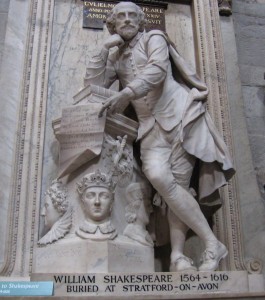From the earliest of times, Shakespeare’s works have been specially admired by women. I wrote a couple of weeks ago about the “Sociable Letter” written by Margaret Cavendish, Duchess of Newcastle and published in 1664. Margaret defended Shakespeare against accusations of rusticity, but also admired his ability to write about people of all kinds:
So well he hath express’d in his playes all sorts of persons, as one would think he had been transformed into every one of those persons he hath describ’d… nay, one would think that he had been metamorphosed from a man to a woman, for who could describe Cleopatra better than he hath done, and many other females of his own creating, as Nan Page, Mrs Page, Mrs Ford, the Doctors Maid, Bettrice, Mrs Quickly, Doll Tearsheet, and others, too many to relate?
Shakespeare’s lack of education was frequently seen as a disadvantage, but for Aphra Behn it was this that gave him a particular appeal for women who also had few educational opportunities. In the preface to her play The Dutch Lover, published in 1673, she wrote “Plays have no great room for that which is men’s great advantage over women, that is Learning; We all well know that the Immortal Shakespeare’s Plays (who was not guilty of much more of this than often falls to women’s share) have better pleas’d the world than Johnson’s works”.
The story that Shakespeare was so liked by Elizabeth I that he wrote The Merry Wives of Windsor at her royal command was first published in John Dennis’s 1702 preface to The Comical Gallant.
In 1726, in his book Shakespeare Restored Lewis Theobald wrote “there is scarce a Poet that our English tongue boasts of who is more the subject of the Ladies’ reading”. But it was really in the 1730s that female enthusiasm for Shakespeare became marked with the foundation of the Shakespeare Ladies Club. Not only did they read the plays, but they lobbied for the performance of Shakespeare’s plays in the theatre over the excesses of popular drama and fashionable Italian operas.
Yet for many years the names of the Ladies of Quality who belonged to this Club were unknown. In his book The Making of the National Poet (to which I owe many of the details in this post), Michael Dobson identifies the leader of the group as Susanna Ashley-Cooper, Countess of Shaftesbury, a well-known patron of the arts who supported the composer Handel and the publication of John Gay’s opera Polly. The aims of the Club were promoted by Mary Cowper’s poem On the Revival of Shakespear’s Plays by the Ladies in 1738 and Elizabeth Boyd, who wrote in the Induction to her play Don Sancho :
And once again let Shakespear bless the Stage;
Soul-soothing Shade, rouz’d by a Woman’s Pen,
To Check the impious Rage of lawless Men.
The Shakespeare Ladies Club is best remembered for its support for a statue of Shakespeare to be put into Poet’s Corner in Westminster Abbey in 1741. The campaign went on for several years: Eliza Haywood wrote that they had “shewn a truly public Spirit in rescuing the admirable, yet almost forgotten Shakespear, from being totally sunk to oblivion: – they have generously contributed to raise a monument to his memory, and frequently honoured his works with their presence on the stage”, and suggests that in doing so their action “will shine to late posterity”.
David Garrick, at his Jubilee more than twenty years later in 1769 remembered that “It was you Ladies that restor’d Shakespeare to the Stage … you form’d yourselves into a Society to protect his Fame, and Erected a Monument to his and your own honour in Westminster Abbey”. The cultivated eighteenth-century gentleman leaning on a pile of books depicted by Scheemakers is probably not quite the image that Margaret Cavendish envisaged, but it’s the most popular image of Shakespeare ever created, endlessly reproduced.
And is the portrait of Queen Elizabeth that can be seen on the base of the plinth a reference to the important role taken by women in promoting Shakespeare’s work?



Thank you for this charming reminder. If you will forgive the self-plug, you can read something about the Wagga Wagga Ladies’ Shakespeare, founded in outback Australia in 1904, here in “Shakespeare and the Drover’s Wife”, along with the commemoration of some other women of quality who worked towards erecting the statue of Shakespeare that today stands outside the Mitchell Library in Sydney: http://www.nla.gov.au/openpublish/index.php/australian-studies/index
Thank you so much for this information. Fascinating how many times women’s groups have promoted Shakespeare!
Thank you for a wonderful article. Shakespeare left infinite clues in his work regarding his attitude toward women. His characters are full of depth, wit and intelligence – both the men and the women. Considering the limits women faced in his time (with the exception of the Queen, of course), it’s a remarkable achievement to see that his feminine characters still ring with vibrancy and courage. In fact, I can find more negative stereotyping of women in many of our modern entertainments than I find in Shakespeare! No wonder women adore him!
Thanks for this comment!
There is also the recently published She Hath Been Reading: Women and Shakespeare Clubs in America by Katherine Scheil which includes a lovely photo of the Dallas Shakespeare Club in 1911.
Many thanks for the information about this new book which I hadn’t heard about. Just goes to show that Shakespeare’s popularity with women readers has continued way beyond the eighteenth century.